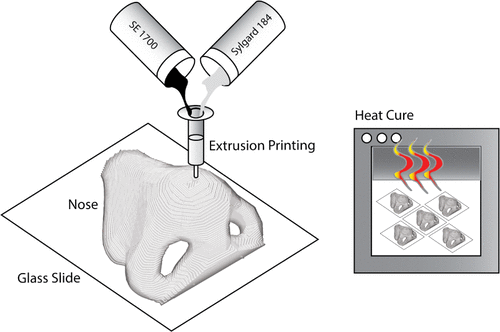当前位置:
X-MOL 学术
›
ACS Biomater. Sci. Eng.
›
论文详情
Our official English website, www.x-mol.net, welcomes your
feedback! (Note: you will need to create a separate account there.)
3D Printing of PDMS Improves Its Mechanical and Cell Adhesion Properties
ACS Biomaterials Science & Engineering ( IF 5.4 ) Pub Date : 2018-01-08 00:00:00 , DOI: 10.1021/acsbiomaterials.7b00646 Veli Ozbolat 1 , Madhuri Dey , Bugra Ayan , Adomas Povilianskas , Melik C. Demirel , Ibrahim T. Ozbolat
ACS Biomaterials Science & Engineering ( IF 5.4 ) Pub Date : 2018-01-08 00:00:00 , DOI: 10.1021/acsbiomaterials.7b00646 Veli Ozbolat 1 , Madhuri Dey , Bugra Ayan , Adomas Povilianskas , Melik C. Demirel , Ibrahim T. Ozbolat
Affiliation

|
Despite extensive use of polydimethylsiloxane (PDMS) in medical applications, such as lab-on-a-chip or tissue/organ-on-a-chip devices, point-of-care devices, and biological machines, the manufacturing of PDMS devices is limited to soft-lithography and its derivatives, which prohibits the fabrication of geometrically complex shapes. With the recent advances in three-dimensional (3D) printing, use of PDMS for fabrication of such complex shapes has gained considerable interest. This research presents a detailed investigation on printability of PDMS elastomers over three concentrations for mechanical and cell adhesion studies. The results demonstrate that 3D printing of PDMS improved the mechanical properties of fabricated samples up to three fold compared to that of cast ones because of the decreased porosity of bubble entrapment. Most importantly, 3D printing facilitates the adhesion of breast cancer cells, whereas cast samples do not allow cellular adhesion without the use of additional coatings such as extracellular matrix proteins. Cells are able to adhere and grow in the grooves along the printed filaments demonstrating that 3D printed devices can be engineered with superior cell adhesion qualities compared to traditionally manufactured PDMS devices.
中文翻译:

PDMS的3D打印可改善其机械和细胞粘附性能
尽管在医疗应用中广泛使用了聚二甲基硅氧烷(PDMS),例如芯片实验室或组织/芯片上器官,护理点设备和生物机器,但PDMS设备的制造仍在仅限于软光刻及其派生类,这禁止了制造几何形状复杂的形状。随着三维(3D)打印的最新进展,PDMS用于制造这种复杂形状的方法引起了人们的极大兴趣。这项研究针对机械和细胞粘附性研究,对三种浓度以上PDMS弹性体的可印刷性进行了详细研究。结果表明,PDMS的3D打印将制造的样品的机械性能提高了3倍,而铸造样品的机械性能却提高了,原因是气泡截留的孔隙率降低了。最重要的是,3D打印促进了乳腺癌细胞的粘附,而铸模样品在不使用其他涂层(例如细胞外基质蛋白)的情况下不允许细胞粘附。单元能够沿着打印的细丝粘附并在凹槽中生长,这表明与传统制造的PDMS器件相比,可对3D打印设备进行工程设计,使其具有更高的单元粘附质量。
更新日期:2018-01-08
中文翻译:

PDMS的3D打印可改善其机械和细胞粘附性能
尽管在医疗应用中广泛使用了聚二甲基硅氧烷(PDMS),例如芯片实验室或组织/芯片上器官,护理点设备和生物机器,但PDMS设备的制造仍在仅限于软光刻及其派生类,这禁止了制造几何形状复杂的形状。随着三维(3D)打印的最新进展,PDMS用于制造这种复杂形状的方法引起了人们的极大兴趣。这项研究针对机械和细胞粘附性研究,对三种浓度以上PDMS弹性体的可印刷性进行了详细研究。结果表明,PDMS的3D打印将制造的样品的机械性能提高了3倍,而铸造样品的机械性能却提高了,原因是气泡截留的孔隙率降低了。最重要的是,3D打印促进了乳腺癌细胞的粘附,而铸模样品在不使用其他涂层(例如细胞外基质蛋白)的情况下不允许细胞粘附。单元能够沿着打印的细丝粘附并在凹槽中生长,这表明与传统制造的PDMS器件相比,可对3D打印设备进行工程设计,使其具有更高的单元粘附质量。









































 京公网安备 11010802027423号
京公网安备 11010802027423号